Crow Village Iditarod Blog
Lockwood puts out Iditarod lantern
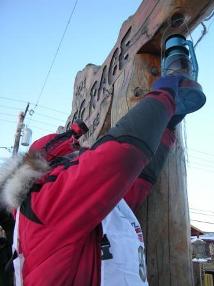 |
| Glenn Lockwood puts out the red lantern Photo by Chas St. George |
Iditarod: 4 Kings beats a full house
Jeff King won his fourth Iditarod race today against arguably the strongest field ever. His winning time for the 1100 mile dog race was 9 days 11 hours and 11 minutes which ranks as 7th fastest all time. As Doug Swingley makes his way to the finish for second place, there are 4 more teams behind him who could finish faster then last year's winning time. They are in order, Paul Gebhardt, DeeDee Jonrowe, John Baker, and Bjornar Andersen. Leading candidates for rookie of the year award are the husband and wife team of Tore Albrigtsen and Tove Sorensen from Tromso Norway who are currently in 22nd and 23rd place at the Elim checkpoint. Legally blind musher Rachael Scdoris and Tim Osmar her visual interpreter have checked into Unalakleet and will soon be making their way up the coast. Holland's first Iditarod musher Ben Valks is bringing up the rear of the pack having checked into Galena. The last racer who finishes wins the Red Lantern award. Surprising everyone with a remarkable "puppy" team is Sonny Lindner who is putting in his mandatory 8 hour layover at White Mountain in 14th place with a 14 dog team. Puppy teams are typically composed of 2 and 3 year old dogs running their first Iditarod as their mushers are trying to season them for a more competitive Iditarod run in the future.
Iditarod 3rd place up for grabs
Jeff King has solidified his first place lead with a 4 hour lead over Doug Swingley, and Swingley holds a 2 hour edge over his closest chaser. With less then 100 miles left on the 1112 mile course the race for 3rd place is heating up. There could be as many as 4 teams in contention for that spot. DeeDee Jonrowe holds the edge right now with a 6 minute lead she has wrestled back from Paul Gebhardt but trailing not too far back are Aliy Zirkle and John Baker. Baker seems to hold the edge on speed right now, but how much the mushers decide to rest their teams comes into play as well. At this point in the race, cutting rest will cut speed, and Jonrowe's team has the most rest in the "bank" at this point. Gebhardt has the least. Gebhardt, Jonrowe, and Zirkle left the Koyuk checkpoint within 10 minutes of each other, and Baker left an hour later. Gebhardt, Jonrowe and Baker eachtook about 6 hours rest at the checkpoint, and Zirkle limited her rest there to nine minutes. All teams are required to take an 8 hour layover at White Mountain, so teams will try to get there as quickly as practical. The distance from Koyuk to White Mountain is 94 miles with the Elim and Golovin checkpoints on the way. That distance can be covered in one go if a team has plenty of rest in the bank. Jonrowe has already chosen to rest 1.5 hours at Elim, and Gebhardt is still resting there. Baker could make the run without rest, but that move would cost him some speed. We will have to see. Zirkle will likely rest somewhere since that has been her pattern the whole race, and she skipped rest at Shaktoolik. I think the order coming into White mountain will be Jonrowe, Baker, Gebhardt, then Zirkle, but we shall see. After the 8 hour rest, it is a 94 mile sprint to the finish line in Nome, since teams seldom take much rest over that stretch after the 8 hour layover. Depending on how tightly packed they are and thespeed differential, there could be some changing of position over that leg. We will see.
Gebhardt makes his move
 |
| Paul Gebhardt Photo by Jeff Schultz |
King opens Iditarod lead
Jeff King has increased his lead to 3 hours over Doug Swingley on the departure from the Shaktoolik checkpoint as Swingley appears to be increasing rest periods for his team. However that lead is not safe given the on-going blizzard conditions along the Bering Sea coast with winds gusting over 30 mph. Both King and Swingley had incidents on the journey into Unalakleet that could have cost them significant time but didn't. They may not be so lucky the next time. Roxy Wright had a chance to interview both at Unalakleet, so be sure to check that out at dogyard.ramybrooks.com. If either should falter, DeeDee Jonrowe has solidified her position as the number 3 team. Behind her is a pack of 3 very good teams in very close proximity - Bjornar Andersen, John Baker, an Paul Gebhardt.
Leaders head to Unalakleet - blizzard awaits
Jeff King was the first musher to leave Kaltag the last checkpoint on the Yukon river shortly after midnight. 35 minutes later Doug Swingley left in hot pursuit. Swingley has erased 3 hours of the substantial lead King had built up since Ruby by traveling faster and cutting rest. Another 2.5 hours back are DeeDee Jonrowe and Aliy Zirkle. Zirkle cut rest at Kaltag, and will likely get caught by a large group of mushers who have been trailing the leaders by some 8 hours. The weather in Kaltag is not good with the temperature hovering around zero and a 15-20 mile an hour wind. From here the trail follows the Kaltag portage for 90 miles over the coastal mountains into Unalakleet on the coast where the weather is decidedly worse. The temperature in Unalakleet is also hovering around zero, but the wind is coming out of the east at 30 mph. Those are miserable conditions for the dogs and mushers alike. Teams will have to stop often, maybe wait for better conditions, and could get lost. This makes for a very unpredictable outcome, so while it appears either King or Swingley will win, and Jonrowe is set up for third, many other outcomes are possible as well with over 250 miles left in the race.
King on record pace - Swingley and Seavey close in
Jeff King continues to lead the Iditarod and has put himself in position to break the time record. He checked into Nulato at 9:19 this morning which is 6 days 16 hours after he started the race in Willow. On Martin Buser record setting run in 2002 he reached the Nulato checkpoint in 6 days 18 hours. King still hasn't sewed up the victory however. After a 3 hour 47 minute rest, he checked out of Nulato, however checking out of Nulato 20 minutes later was Doug Swingley. Swingley's team is running faster then King's and now he seems to be cutting some rest. Swingley was 3:30 behind King checking into Galena however, King rested there 5:50, and Swingley only stayed 4:30. King made the 52 mile run from Galena to Nulato in 5:51 but Swingley made it in 5:04. King rested in Nulato 3:47 however Swingley rested on:31. If Swingley chooses not to rest on the 42 mile jaunt to Kaltag and continues at the same pace, he will pass king by Kaltag. Both will certainly take a good rest there before heading out over the pass from the Yukon river to the Coast. Mitch Seavey has surprisingly jumped into the mix, and is now running in 3rd place. Mitch cut rest at Galena, so he will likely have to make that up sometime before Kaltag, but he left that checkpoint 8 minutes after Swingley, so if either King or Swingley's team start to falter, or the weather turns, it could very well be his race to win. Stay tuned...
King maintains Iditarod lead
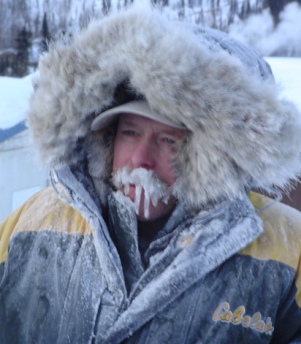 |
| Frosted Jeff King at Ruby Photo by Tony Wright |
Iditarod weather gets COLD!
 |
| Doug Swingley at Takotna Photo by Robert Sørley |
Iditarod departure times from Cripple
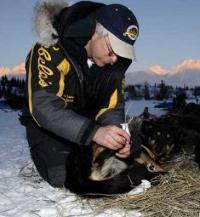 |
| Jeff King applies salve Photo by Marc Lester |
Paul Gebhardt has resumed the lead in the Iditarod departing the Cripple checkpoint first at 1:48 pm after a 5.5 hour rest there. He has yet to take his mandatory 24 hour layover however. So far the trail in this year's Iditarod race has been soft because of warm weather and recent snow fall. That has meant slower times and less injuries for the dogs. That all changed last night when the temperature dropped to 40 below at Cripple. Those who decided to take their 24 hour layover's early should benefit from this. They would be able to travel the same sections of trail already traveled by teams opting to layover farther in the course at a faster speed. Two factors combine to make the trail firm up - traffic by the snowmobile trailbreakers and dog teams, and cold weather. The combination of these 2 should have produced a fast trail today between Takotna and Cripple. We are now starting to see proof of this. Teams who chose to layover at Takotna are posting 20% faster run times. Jeff King was the first to leave Takotna with the layover complete. He could reach Cripple by 7:30 pm tonight. Assuming he takes a 6 hour rest, he could depart at 2 am. Doug Swingley arrived at Cripple first and will come off his 24 hour layover at 2:47 am tomorrow. Aliy Zirkle who completed her 24 at Takotna could arrive at Cripple by 10 pm. With a 6 hour rest she would depart at 4 am. DeeDee Jonrowe comes off her 24 at Cripple at 4:37 am. So with the exception of Gebhardt who will statistically be in the lead until he stops for the 24, that is how we see the leader board tomorrow - 1) King, 2) Swingley, 3) Zirkle, and 4) Jonrowe with a 2.5 hour spread from 1st to 4th. This should get exciting
Iditarod halfway point
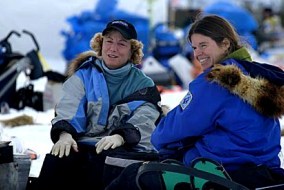 |
| DeeDee chats with Susan Butcher (2004) Photo by Al Grillo |
Doug Swingley has reached the halfway point at Cripple, and other teams have started taking their 24 hour layovers further back. The consensus is that Swingley will take his 24 hour layover plus 2 hour 48 minute start differential here. DeeDee Jonrowe has moved into second place with a team that is arguably running the fastest right now, however she is long overdue into Cripple. It could be that she has already checked in there and the Iditarod volunteers missed the update as sometimes happens. Camped back at the hospitable Takotna checkpoint likely taking their 24 are Jeff King and Aliy Zirkle. Based on their time in there, and the start differential makeup that occurs on the 24, they will come off that break as first and second place, however, when Swingley finishes his layover, he will jump right back into the mix into one of the top 3 spots. We think Jason Barron and Mitch Seavey are taking their 24s at Ophir. These 2 teams appear to be racing together, and are 3 hours off the pace set by Swingley into Ophir. Seavey historically runs a very fast second half, so if the leaders slow and Jason Barron hangs with him, they could very well be right in the mix. Jason's father, John Barron, Ed Iten, Bjørnar Andersen, Jacques Philip, Martin Buser, Ramy Brooks, and Rick Swensen all seem to be taking a break at Ophir as well. Philip is running a remarkable race. His dogs have never run a race longer then 460 miles since he typically runs stage races. He told us earlier that he didn't expect to be competitive, just finish and make sure the dogs enjoyed the event. Well he appers to be running very competitive keeping pace with some first class teams. Norwegian mushers Tore Albrigtsen and his wife Tove Sørensen are currently in good position for rookies of the year and at one point were sharing the trail with all-star Norwegian musher Bjørnar Andersen. They are co-racing, so perhaps they can be co-winners of that award? They appear to be laying over in Takotna and could well come out of that rest in a top 20 position or better. As they explained to us earlier, they are not in Alaska for a vacation.
Iditarod mid race confusion
As we approach the mid point of the Iditarod race, confusion is inevitable. This is the period where teams will start taking their mandatory 24 hour layover. Bear in mind also that the start differential gets tacked on to the 24 hour layover, thus teams who started last have shorter layover then teams like Doug Swingley who started 4th. Add to that, a mandatory 8 hour layover on the Yukon river which is fast approaching, and you can quickly understand how keeping track of who is in front becomes very difficult. It is not unusual for teams to leverage this period of confusion to make strategic moves as well. In short, once the layovers start, we can only speculate where all the teams fall out until everyone completes their 24 and 8 hour layovers. But the layovers have not started yet, so let's take this opportunity to get our bearings. Doug Swingley and Jeff King are certainly leding the race. Doug checked into the Takotna checkpoint 436 miles into the race first at 2:25 this morning. Jeff came in 35 minutes later. At this point, that is a slim lead, however, Swingley has a 2 hour 38 minute start differential, and King's is 1 hour 48 minutes. In theory, King is 15 minutes ahead when you take into account the differential. For our purposes, we'll call it a dead heat. Other teams into Takotna include Aliy Zirkle at 5 am and DeeDee Jonrowe at 6. Considering the start differential, they are both within 2 hours of the lead. Roxy spoke to Aliy at Nikolai, and Aliy confirmed she is maintaining her pre-planned schedule. She told us she would try and stick with the leaders until the Yukon river, and then see if her team had it in them to make the push. We won't know if that works for her until this period of confusion ends, but we'll try to keep track. DeeDee by all accounts has a good looking team and is consistently making up time. She has the leaders nervous. Others in the pack could still make their move. Ramy Brooks and Bjornar Andersen both seem to have altered their schedules to accommodate the ebb and flow of the race, but will these adjustments work? With more then half of the race left, they certainly aren't about to give up. The surprise so far has got to be Paul Gebhardt. Gebhardt finished 2nd in the 2000 Iditarod but decided to retire after that. As sometimes happens, he decided to come out of retirement in 2003, and like fellow ex-retired musher Doug Swingley, had to start seasoning a team again to become competitive. As many now know, Gebhard had an incident on the way into Nikolai where his team got away and Swingley helped him out with a ride. Gebhardt seems to have shaken that episode off, and is once again running with the leaders, however don't forget about the start differential. Gebhardt started dead last, which gives him a 2 hour 38 minute advantage over Swingley at the 24. Maybe he'll get a chance to return the favor?
Swingley and King lead
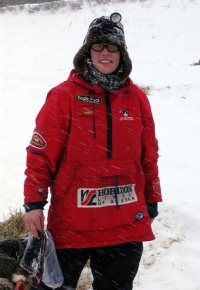 |
| Aliy Zirkle at Nikolai Photo by Tony Wright |
Who is in the lead?
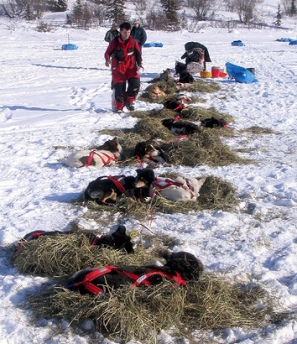 |
| Ramy Brooks and team at Rainy Pass Photo by Tony Wright |
Montana mushers set the pace
Lincoln Montana musher and 4-time Iditarod champion Doug Swingley was the first musher to leave the Rohn checkpoint. Fellow Montana mushers Jason and John Barron left 5th and 6th less then 2 hours behind. Jason hails from Lincoln also, and his father John lives in nearby Helmville. John has run more then 20 iditarods. Also leaving Rohn were Jeff King, Ramy Brooks, Aliy Zirkle, and Mitch Seavey. Will the winner come from this pack? Maybe, but it is still to early to tell. I can assure you that everyone of these teams will be looking over their shoulder for the Norwegian team of Bjornar Andersen. Bjornar who is still resting in Rohn took a slight detour earlier in the race after the Finger Lake checkpoint, where he followed the wrong trail markers for 40 minutes before turning around loosing about an hour and a half. Also resting in Rohn are DeeDee Jonrowe, Jessica Hendricks, Lance Macky, 3-time winner Martin Buser, John Baker, and Ed Iten. Given the slow trail conditions this year, any one of these teams could challenge for the lead. The trail to the Nikolai checkpoint is a flat 93 mile adventure over the Farewell burn. Teams that did not rest at Rohn will be resting on the trail, but those who did rest may decide to make the run in one go. It should be noted that DeeDee started in 31st position, so she has a 52 minute time differential over Swingley (who started 5th) which will be made up at the 24 hour layover. Big Lake, Alaska musher Cim Smyth who just checked out of Rohn in 11th has the largest time differential of the leaders at over 2 hours. Checking out of Rohn just prior to Cim is 5 time iditarod champ Rick Swensen. Rick has not won the race since 1991.
Swingley first into Rainy Pass
4-time Iditarod winner Doug Swingley became the first musher to check into the Rainy Pass checkpoint 224 miles into the race. We expect Doug to rest his team a bit here before leaving the lodge for the 48 mile jaunt up the pass and down the always tricky Dalzell Gorge. Also, his dogs may need the rest given this area has some fresh snow, and the first team through typically does more work. 40 minutes after Doug's arrival, 3 time Iditarod winner and and 8 time K300 winner Jeff King checked in. 5 minutes later, Ramy Brooks came in. It would not surprise us to see these 3 push the pace through most of the race, but there will be others as well given this is still early and the run and rest schedules for the mushers will vary greatly depending on their strategy. All eyes are on the trail watching out for Bjornar Andersen, the musher from Team Norway many expect to win. If he follows theschedule set by his team mates in previous years, he may just blow right through the Rainy Pass checkpoint and wait until Rohn to rest the team. Lance Mackey who was first to Finger Lake has not left that checkpoint yet, but he should shortly, and when he does, we expect him to run long too as he demonstrated in the Yukon Quest race this year. It is interesting to note that 25 teams passed Mackey while he was resting at Finger Lake, but we don't think he is concerned.
Mackey first to Finger Lake
Fresh off his victory in the 1000 mile Yukon Quest 10 days ago, Lance Mackey has shown that his dogs have plenty of get up and go left by becoming the first musher to check into the Finger Lake checkpoint. While it is still very early in the race, and lead changes will be frequent as teams settle into their schedules, this is an impressive move by Mackey who started the race in 23rd position. Along the way to Finger lake he has passed such teams as Ramy Brooks, Ed Iten, Mitch Seavey, and Doug Swingley. We expect a few more teams will check into Finger Lake before Lance hits the trail again.
Bearss takes early lead
Rookie musher Brian Bearss of Anchorage has taken the early lead in the Iditarod race, departing the Skwentna checkpoint first with a team of 15 dogs. Ramy Brooks, Melanie Gould, Ramey Smyth, and Jeff King round out the top 5. Ironically, Bearss once worked for King at his kennel. Bearss started the race fourth, and has already passed 4 time winner and frequent front runner Doug Swingley however King has made the most significant move having started 28th in the 83 team field. From Skwentna, the trail now heads uphill towards Finger Lake, and after that is the rugged trail up Rainy Pass.
Musher profile: Jessica Hendricks
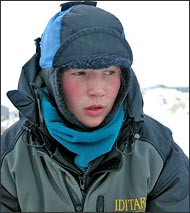 |
| Jessica Hendricks |
Musher profile: Jeff King
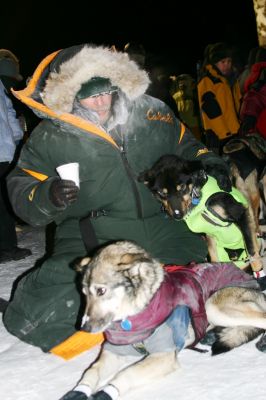 |
| Jeff with Bronte (L) and Bernard Photo by Justina Phillip |
Perhaps that is why Jeff believes in innovation. Jeff has won the Iditarod race 3 times, but he hasn't won it since 1998. No musher has revolutionalised long distance dog racing more then Jeff King over the last several years. Some of his ideas have literally shocked the mushing world. In 2001 he started racing teams without benefit of neck lines. This was unheard of until that time, and in fact some races still require them. Necklines keep the dogs from straying too far from the tug line thus requiring them to pull at a straighter angle. Jeff figured they wasted energy, and he could do without if the dogs were trained better. Anyone who has seen Jeff's teams in action over the last few years will readily verify he got the training right. In 2003, he abandoned the traditional harness which pulled straight from the back of the dog, to a harness that pulled from the side midway back. Mushers thought he had finally lost his mind, but Jeff figured his dogs would be more comfortable pulling this way given they would not have to run kiddywampus to pull on a tug line that was along side of them. In 2004 he focused his attention on the sed which had remained largely unchanged since the dawn of dogsled racing. He split the cargo area in two, and placed himself in the middle, effectively giving himself a place to sit. This bark-o-lounger idea caught on quickly with the other mushers. He refined the sled some more in 2005 adding a doggie hold on the back where he could rest one of his dogs rather then in the traditional hold. He found his dogs could be more useful resting there then in the old spot, but this also enabled him to make his sled articulating, which greatly increased the stability.
We fully expect some new ideas from Jeff again this year. He has tinkered with the sled some more, but he has also picked up a dog training idea from observing Norwegian Bjornar Andersen's team at last year's Iditarod. While Bjornar and him were waiting for Dee Dee Jonrowe to untangle her team from a pileup at the bottom of Dalzell Gorge, he noticed that Bjornar's team just sat there waiting, while his team was all excited. This of course registered with Jeff. When the dogs get excited, they waste energy. Now when he gets ready for a training run, he lets the dogs sit in harness for a few hours before taking off, and as a result, he dogs have learned to stay calm until it is time to go. Another new training trick Jeff tried this summer included some doggy paddling in Goose Lake at his Denali Park Kennel. He tethers a team to a buoy, and lets them take off. The dogs really seem to enjoy it, and it certainly provides for a low impact workout without overheating in the summer sun.
This January Jeff served notice that he is a force to be reckoned with in this running of the Iditarod at the Kuskokwim race. Against a field that included 10 mushers who have had top ten finishes in the Iditarod, he finished first in a record time. This is his eighth victory in that race. Jeff had his top dogs in that team, and believes the experience and training gained by those dogs including one very promising young leader will go a long ways towards getting him to the bured arch first.
Fielders scratch at Aniak
The Kuskokwim 300 leaderboard has now confirmed that Linwood and Dalton Fielder have scratched at Aniak. With temperatures hovering around minus 35 (fahrenheit or celsius - take your pick), we were unable to dispatch a reporter in Aniak to find out more. Martin Buser passed the Akiachak checkpoint at 9:50 am with 7 dogs still on the team and should be to Bethel about noon in what has to be a disapointing race for him.
King hangs on to win
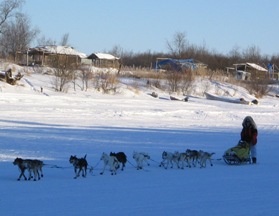 |
| Seavey's team passing Tuluksak Photo by Justina Phillip |
King extends lead
Jeff King now appears to have a sizable lead in the Kuskokwim 300. King elected to take his 6 hour layover in Kalskag rather then push through to Aniak, and that strategy appears to have paid off. Mitch Seavey, and Ed Iten chose the same strategy, and they are currently running second and third. King has a 30 minute advantage over Seavey and 45 minutes over Iten. Ramy Brooks who took the layover in Aniak is fourth another 20 minutes behind. Martin Buser who was first to arrive in Aniak is now in 7th with 8 dogs still on the team. Martin dropped 5 dogs in Aniak. Lisa went to the community center to check on those 5 and reports that they are looking fine. The handler there said that Martin did not provide any explanation why he was dropping them. Jerry Riley and Mark May lost the trail coming out of Kalskag (outbound) and wasted about 3.5 hours finding it again. May ended up scratching at Ania. Nathan Underwood reached his hometown of Aniak, but scratched there as well as his homesick dogs refused to leave. Linwood Fielder is holed up in Aniak waiting for his son Dalton, and is concerned he may be lost. Both Linwood and Dalton took their layover in Kalskag, and Dalton left Kalskag 25 minutes after Linwood.
Buser and Brooks lead K300
 |
| Ramy Brooks at start Photo by k300.org |
Kusko 300 to start Monday
Cold weather delayed the start of the Kuskokwim 300 once again. Race is scheduled to start noon (ADT) Monday. Forcast calls for 10 degress warmer on Monday (minus 10) with diminishing winds, so hopefully they will get it kicked off.
Kusko "255" start delayed
Bitter cold weather forced a delay to the start of the Kuskokwim 300 dog race by 2 days. Additionally, the 45 mile Pike Lake spur section and second Aniak checkpoint have been dropped from the route. Temperatures Friday in Bethel hovered near the minus 20 range with wind-chill dipping to around minus 60. Those frigid temperatures raise concern about the safety of the dogs, mushers, and volunteers working the long cold hours, but the factor most responsible for putting the start on ice was the grounding of air travel at the Bethel airport making logistics support next to impossible. The start has been re-scheduled for Sunday noon. Sunday's weather calls for a balmy high of minus 10 by midday. The cold weather should favor mushers Aliy Zirkle of Fairbanks, Ed Iten and John Baker of Kotzebue, and Ramy Brooks of Healy, all who have trained their teams extensively in cold weather climates. Expect the first teams to pass Crow Village Monday morning.
Musher profile: Jacques Philip
 |
| Jacques Philip Photo by Jacques Philip |
Last year, Jacques decided to enter the Iditarod again. He found his dogs were doing more and more distance work in preparation for stage races, and reasoned that a 1000 mile race would not be a stretch for them. He didn't get a chance to test that theory out however. A little more then 200 miles into the race coming up on Rainy Pass, Jacques crashed into a tree and dislocated his right hand. He stabilized it by wrapping it in duct tape, although we are not sure if he learned that trick at medical school or from the teachings of Joe Reddington Sr. Potential problems handling the dogs one handed on the difficult trail sections ahead, along with the significant swelling and risk of infection to the hand forced him to scratch at Rainy Pass. He decided to give the Iditarod another try this year becoming the 99th musher to register.
We asked Jaques about his training and racing plans leading up to the Iditarod. Magali and him will each enter a team this January in the 1000 kilometer La Grande Odessee stage race taking place in France. Jacques told us, "This race is important for us because of course it is in France where we have family and they can come and visit us, but also because it has a big potential for media coverage and sponsorship". Next up is the 290 mile Wyoming Stage Stop stage race across Wyoming starting January 27. Jacques and Magali finished 2nd and 9th respectively in that race last year. Jacques does not know how long it will take him to get to Nome, but he is not concerned about that. His primary objective will be to keep his dogs and himself from getting hurt. Magali maintains a blog hilighting the training progress.
Musher profile: Aliy Zirkle
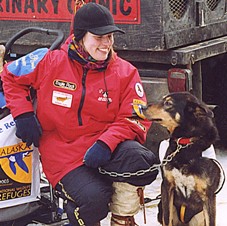 |
| Aliy with Pedro Photo by Donna Dewhurst |
Aliy runs the Skunks Place kennel with her husband and fellow musher Allen Moore. It is a family run operation. Aliy and Allen run the dogs, and Aliy's sister Kaz manages the whole operation. They keep the number of dogs low enough to where they don't require handlers to help with the training. Aliy thinks that helps keep her in shape, and more in touch with the dogs. Two Rivers has not had much early season snow this year, but the training has been going good none-the-less with the teams pulling four-wheelers until the first part of December, and working harder now with the sleds now that the snow is sufficient.
The dogs from Skunk's Place kennel will be running in a few 200 and 300 mile races this season in preparation for the Iditarod. Allen will take a team to the Copper Basin 300. This is a race Allen won last year. Aliy will take a young team to the Kuskokwim 300. This is her first time to race the K300, but she has a large group of 2 year old dogs who have never raced, and she needs to see how they will handle a tough demanding race. She plans on including a few seasoned leaders on that team to help show the young ones the ropes. Both Aliy and Allen will enter the Tustumena 200. Last year, Aliy finished 3rd and Allen finished 11th in the Tustumena. With this racing complete, they hope to pick the likely candidates for the Iditarod team and test them at the Yukon Quest 300.
Aliy has shown she can race with the top dogs winning the Yukon Quest 1000 in 2000 and finishing 11th last year at the Iditarod. She is still tweaking her Iditarod race plan, but she figures this racing will help to decide that and really decide which dogs will help her win. She doesn't anticipate starting fast, but hopes to pick up speed later in the race when the other teams start to fade. We anticipate she will do very well.
Doug Swingley joins K300 field
The 4 time Iditarod winning musher Doug Swingley from Lincoln Montana became the
latest elite musher to register for the Kuskokwim 300 (K300)
dogsled race. Doug begins his third season returning from retirement, and we don't
typically see Doug race in Alaska prior to the Iditarod, so this will be a rare opportunity to
see how he stacks up against some of the top teams. Mushers who have already
registered for the K300 include Aliy Zirkle, Paul Gebhard, Jeff King, Martin Buser, and
Mitch Seavey. King, Buser, and Seavey of course have each won the Iditarod at least
once, and all 5 challenged for the lead in last year's Iditarod running second or higher at
least one checkpoint during the race. DeeDee Jonrowe, Ramy Brooks, and Ed Iten are 3
more mushers who ran as high as second at some point in last years Iditarod. Those 3 all
ran the K300 last years so we would not be surprised to see them submit their
registrations in the coming weeks. This should make for a very competitve race. The
K300 route has been altered slightly from last year's route. Like last year, the route
passes Crow Village on the way to the Aniak checkpoint, however, upon leaving Aniak,
instead of looping down to Whitefish Lake, the teams will do an out and back to Pike Lake,
returning to check in at Aniak for a second time. This is being done to increase the
involvement of Aniak in the race. As an added bonus, the route passes Crow Village again
on the return back to Bethel marking the first time in the 26 year history of the race that
the mushers pass Crow Village twice.
Susan Butcher begins treatment for leukemia
Susan Butcher, is a four-time champion of the Iditarod. She won those four races over a span of 5 years in the later eighties and during that time she was the most dominant athlete in long distant dogsled racing. She was diagnosed last week with acute myelogenous leukemia (AML), and has since begun treatment. Leukemia is a malignant disease of the blood and bone marrow, and she is undergoing chemotherapy treatment at Fred Hutchison Cancer Research Center at the University of Washington, Seattle. On her behalf, the Blood Bank of Alaska is organizing a statewide donor drive on December 30th to test anyone who would like to donate. Updates on this program and her progress can be found at www.susanbutcher.com.
Dean Osmar becomes 103rd entrant
 |
| Dean Osmar Photo by Joe Runyan |
Dean Osmar from Clam Gulch, Alaska on the Kenai peninsula became the 103rd entrant in what may
well become a record size field for the 34th Iditarod. It
is still possible for more entrants to be considered provided their form was postmarked by December 1st,
and I can certainly attest to mail delays sometimes experienced in Alaska. Typically some qualified
entrants will not end up in the race for various reasons, but the most typical reason would
be rookies failing to meet race qualification requirements prior to the race. Dean will not fall into
that category since he has completed the race twice before. In 1982 he finished 12th, and in 1984 he
shocked many by winning. It is worth noting that his winning time that year was in 12 days and 15 hours.
He would need to cut about 3 days off that time to put himself in contention these days. Dean
has a son (Tim) also running the race this year. Tim Osmar has volunteered to be the visual interpreter
for visual impaired musher Rachael Scdoris. Tim is a perennial top 20 finisher who has finished
as high as 3rd. Tim is fielding a very young team this year, so he didn't figure on being competitive
yet still wants to get those doggies some valuable trail experience to make for a more
competitive push in the future, so volunteering to help Rachael became the obvious choice for him.
This is actually the second time both Dean and Tim have raced the Iditarod together.
The first time was in 2003. Tim finished 22nd that year, however Dean decided
to scratch at Galena after contracting salmonella from a bad hamburger he ate in Fairbanks.
Iditarod registration reaches 100
Musher registration for the Iditarod officially closed December 1st with 99 entrants showing at that time. However, registrations only had to be postmarked by then, so a few more were expected to trickle in. Today, the official iditarod website showed the 100th entrant - Ray Reddington Jr. If that name sounds familiar, it should. He is the grandson of Iditarod founder, Joe Reddington Sr. Also, the field is heating up for the Kuskokwim 300, which should give us a good indication of how some of the teams stack up against each other. As you may know, the K300 passes right by Crow Village so we tend to get some inside information from that event. Entrants worth watching in the K300 so far include Jeff King, Aliy Zirkle, Martin Buser, and Paul Gebhardt.
Musher profiles: Tove Sørensen and Tore Albrigtsen
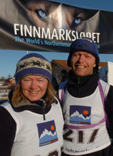 |
| Tove & Tore |
Tove and Tore have plenty of experience, but seemingly they gain additional benefits from each other. Each year they mush in Finland's rugged 1000 kilometer Finnmarksløpet race. Their strategy is to race both teams together as long as they both stay strong. For the last 6 years, Tove and Tore have crossed the finish line at the Finnmarksløpet at the same time, and those finishes have been in the top 10 for each. Apparently that strategy has some merit for them. Dogs for both teams come from their 130 dog kennel at the Tromsø Wilderness Centre . This kennel also serves as the canine workforce for entertaining the guests, so obviously the dogs and mushers from both teams are very familiar with each other. We have verified that the burly arch in Nome is wide enough to accommodate double finish, so we will be watching closely to see if they can pull that off.
We caught up with Team Tove & Tore in Norway via email just as they were preparing to leave for Alaska to attend the rookie meeting. Tore is already familiar with the Iditarod route having skijored the route in 1997, so we asked him about that experience. Tore tells us that it was "a great adventure. A good way to see the Alaska, but probably not the easiest way." That adventure took him 19 days and 7 hours to complete. We were curious if the other Norwegian Iditarod racers offered any inspiration. "Of course they have given good (advice) about the race, but we still have to drive our own dogs to Nome by our self." What level of racing can we expect from Norwegian mushers? "The results from Robert, Kjetil and Bjørnar is of course really good, but that also (is) telling about the level in Norway. It could be more good mushers who did Iditarod but it cost a lot to do it and the marked for sponsors are not like in US." We asked what their target finish time would be. "(Since this is the) first time Iditarod, we don't know what will happen, but we are not coming for a holiday…"
It is difficult for us to predict a top 10 Iditarod finish for Tove and Tore at this time. There results at the Finnmarksløpet have not been as impressive as the other Norwegians Robert Sørlie, Kjetil Backen, and Bjørnar Andersen, each of who have won that race. It is a significant commitment to field 2 teams from Norway in this race, so we are confident we will see a competitive effort however. Can they cross the finish line together? Only time will tell, but we will definitely be watching.
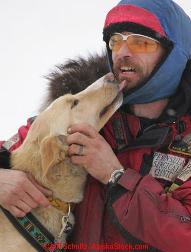 |
| Lance with Scotch |
The fact that Mackey is mushing at all is an impressive feat. Doctors told him he would never mush again after a battle with cancer in 2001 resulted in major surgery on his neck. His doctors predicted after that surgery that he would only regain about 10 percent mobility in his arm. Despite that prognosis, however, Lance worked hard and eventually regained almost complete mobility in that arm. Complete with the exception of that index finger that is. Proper feelingwould never return to that finger, and the cold conditions would aggravate it to the extent to where not only was it unusable, but the throbbing pain was almost unbearable. He vowed to change that situation. Doctors gave him 2 choices - continue with physical therapy with the quickly fading hope that the condition would improve, or surgically remove the problem digit. He chose the latter.
Success in dogsled racing has 3 major components. The natural ability of the dogteam, training strategy, and performance of the musher. Lance proved last year that he had a viable team of young dogs, and with many of those dogs now reaching their prime, they will be a force to reckon with. Lance's ability to perform should be a notch better this year given he no longer has the finger pain to deal with, and the digit he lost was of no use to him last year anyway. The training strategy is the big question mark at this point. During his rehabilitation from the surgery, his handlers have had a much larger role in the trainng program. Will this affect the way the dogs respond to him? We should get or first clues on that when he completes the Sheep Mountain 150 next month - a race that he won last year. Once again Lance plans on racing the 1000 mile Yukon Quest which finishes a scant 2 weeks before the start of the Iditarod. The conventional wisdom suggests that is not a good strategy, but it is a strategy that brought success for lance last year.
This is one team we will be keeping a close eye on.
81 Mushers registered for 2006 iditarod
81 mushers have registered so far for the 2006 Iditarod. The racers will begin their trek to Nome the
weekend of March 4, 2006, and you can find news and highlights for that event right here.
Among those registered so far include Bjørnar Andersen, Mitch Seavey,
Ramy Brooks, Martin Buser, Jeff King, Rick Swensen, Ed Iten, Doug Swingley,
Jessica Hendricks, Lance Mackey, Aliy Zirkle, DeeDee Jonrowe, Rachael Scdoris, and Tove Sørensen and Tore Albrigtsen. Watch in
the coming weeks as we highlight stories for each of these mushers and possibly a few more.
Registration begins for the Kuskokwim 300
The Kuskokwim 300 (K300) dogsled race begins January 20th at 6:30 pm. Iditarod mushers often use this race to tune up the dogs and their strategy, along with scoping out the competition. Given the proximity of the race route to Crow Village, the Crow Village Iditarod weblog reporting team keeps a close eye on this race to better gauge the dogsled team strengths and get inside information. So far, Jon Little and Mathias Blum have signed up. Jon has run the iditarod race several times finishing as high as fourth in 2002. Mathias is attempting to qualify for the Yukon Quest dogsled race. The Yukon Quest is a 1000 mile race from Fairbanks Alaska to Whitehorse Yukon Territories.
More blogs about iditarod.
Comments or questions? Contact feyer1 (at) gmail dot com
Links
IditarodCabelas Iditarod
Ramy Brooks
Bjørnar Andersen
APRN
Team Tove & Tore
Rachael Scdoris
Tyrell Seavey's Blog
Joshua Rogers' Blog
Noatak Kennel Blog
Iditarod Flyover
Crow Village Alaska